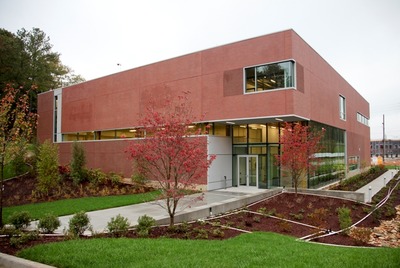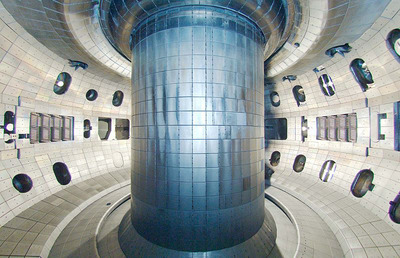Washington, D.C., USA - November 14, 2014 - U.S. Secretary of Energy Ernest Moniz today announced two new High Performance Computing (HPC) awards to put the nation on a fast-track to next generation exascale computing, which will help to advance U.S. leadership in scientific research and promote America's economic and national security. Secretary Moniz announced $325 million to build two state-of-the-art supercomputers at the Department of Energy's Oak Ridge and Lawrence Livermore National Laboratories. The joint Collaboration of Oak Ridge, Argonne, and Lawrence Livermore (CORAL) was established in early 2014 to leverage supercomputing investments, streamline procurement processes and reduce costs to develop supercomputers that will be five to seven times more powerful when fully deployed than today's fastest systems in the U.S. In addition, Secretary Moniz also announced approximately $100 million to further develop extreme scale supercomputing technologies as part of a research and development program titled FastForward 2.
 |
Energy Secretary Ernest Moniz, left, tours Austin Community College's ACCelerator, a high-tech learning lab that provides access to more than 600 computers for individualized learning and small group sessions.
ACC’s ACCelerator helps students focus on developing the in-demand technical skills needed in growing local industries, including in the energy sector.
Secretary Moniz was joined by a group of students and school administrators.
Photo courtesy of U.S. DOE / Derek Posey, ACC |
| |
Washington, D.C., USA - November 14, 2014
U.S. Secretary of Energy Ernest Moniz today announced two new High Performance Computing (HPC) awards to put the nation on a fast-track to next generation exascale computing, which will help to advance U.S. leadership in scientific research and promote America’s economic and national security.
Secretary Moniz announced $325 million to build two state-of-the-art supercomputers at the Department of Energy’s Oak Ridge and Lawrence Livermore National Laboratories.
The joint Collaboration of Oak Ridge, Argonne, and Lawrence Livermore (CORAL) was established in early 2014 to leverage supercomputing investments, streamline procurement processes and reduce costs to develop supercomputers that will be five to seven times more powerful when fully deployed than today’s fastest systems in the U.S.
In addition, Secretary Moniz also announced approximately $100 million to further develop extreme scale supercomputing technologies as part of a research and development program titled FastForward 2.
 |
Dr. Ernest Moniz, United States Secretary of Energy.
As United States Secretary of Energy, Dr. Ernest Moniz is tasked with implementing critical Department of Energy missions in support of President Obama’s goals of growing the economy, enhancing security and protecting the environment.
This encompasses advancing the President’s all-of-the-above energy strategy, maintaining the nuclear deterrent and reducing the nuclear danger, promoting American leadership in science and clean energy technology innovation, cleaning up the legacy of the cold war, and strengthening management and performance.
Photo courtesy of U.S. DOE |
| |
“High-performance computing is an essential component of the science and technology portfolio required to maintain U.S. competitiveness and ensure our economic and national security,” Secretary Moniz said.
“DOE and its National Labs have always been at the forefront of HPC and we expect that critical supercomputing investments like CORAL and FastForward 2 will again lead to transformational advancements in basic science, national defense, environmental and energy research that rely on simulations of complex physical systems and analysis of massive amounts of data.”
 |
Supercomputer simulations enable researchers to address the most challenging problems in diverse scientific arenas.
Pictured is a volume rendering of shear-wave perturbations computed in the seismology simulation code SPECFEM3D_GLOBE.
Photo courtesy of Oak Ridge National Laboratory / Dave Pugmire |
| |
Both CORAL awards leverage the IBM Power Architecture, NVIDIA’s Volta GPU and Mellanox’s Interconnected technologies to advance key research initiatives for national nuclear deterrence, technology advancement and scientific discovery.
Oak Ridge National Laboratory’s (ORNL’s) new system, Summit, is expected to provide at least five times the performance of ORNL’s current leadership system, Titan.
Lawrence Livermore National Laboratory’s (LLNL’s) new supercomputer, Sierra, is expected to be at least seven times more powerful than LLNL’s current machine, Sequoia.
Argonne National Laboratory will announce its CORAL award at a later time.
 |
Buildings Technology Research & Integration Center.
The Buildings Technology Research & Integration Center (BTRIC) user facility at ORNL is the premier US research facility devoted to the development of technologies that improve the energy efficiency and environmental compatibility of residential and commercial buildings.
BTRIC’s mission is to identify, develop, and deploy energy-efficient building system technologies by forming partnerships between DOE and private industry for technology development and analysis, well-characterized laboratory and field experiments, and market outreach.
Photo courtesy of Oak Ridge National Laboratory |
| |
The second announcement today, FastForward 2, seeks to develop critical technologies needed to deliver next-generation capabilities that will enable affordable and energy-efficient advanced extreme scale computing research and development for the next decade.
The joint project between DOE Office of Science and National Nuclear Security Administration (NNSA) will be led by computing industry leaders AMD, Cray, IBM, Intel and NVIDIA.
In an era of increasing global competition in high-performance computing, advancing the Department of Energy’s computing capabilities is key to sustaining the innovation edge in science and technology that underpins U.S. national and economic security while driving down the energy and costs of computing.
 |
Scientific User Facilities
Courtesy of Argonne National Laboratory |
| |
The overall goal of both CORAL and FastForward 2 is to establish the foundation for the development of exascale computing systems that would be 20-40 times faster than today’s leading supercomputers.
Collaboration of Oak Ridge, Argonne, and Livermore (CORAL)
The Collaboration of Oak Ridge, Argonne, and Livermore (CORAL) is a joint procurement activity among three of the Department of Energy’s National Laboratories launched in 2014 to build state-of-the-art high-performance computing technologies that are essential for supporting U.S. national nuclear security and are key tools used for technology advancement and scientific discovery.
 |
Cities of the future - with big data.
LakeSim is an Argonne-developed tool that merges urban design with scientific analysis to aid in the design of 21st century cities.
To address the uncertainty of large-scale planning with so many complex variables, LakeSim creators have prototyped a new platform that seeks to help developers plan at massive scales while anticipating the ability to build in future scenarios such as climate change, improved efficiency in buildings and transportation systems, and increased renewable energy and/or micro-grid applications.
Photo courtesy of Argonne National Laboratory / Mitch Romanowski and Mary Jo Koelbl |
| |
CORAL is jointly led by the Office of Science’s two Leadership Computing Facility centers at Oak Ridge National Laboratory (ORNL) and Argonne National Laboratory (ANL), and The National Nuclear Security Administration’s facility at Lawrence Livermore National Laboratory (LLNL).
The collaboration will procure leadership computing systems for the three National Labs and is part of a national strategic computing effort that would align strategies and resources across the federal enterprise.
Technical Details of CORAL
Both CORAL awards announced today leverage the IBM Power Architecture, NVIDIA’s Volta GPU and Mellanox’s Interconnected technologies to advance key research initiatives for national nuclear deterrence, technology advancement and scientific discovery.
Oak Ridge’s new system, Summit, is expected to provide at least five times the performance of ORNL’s current leadership system, Titan.
Livermore’s new supercomputer, Sierra, is expected to be at least seven times more powerful than LLNL’s current machine, Sequoia.
Argonne will announce its CORAL award at a later time.
 |
A rendering of the inside of the DIII-D Tokamak.
Tokamaks are devices that use a magnetic field to confine plasma in the shape of a torus, which looks like doughnut.
The plasma is produced by heating a mixture of deuterium and tritium – two isotopes of hydrogen – to temperatures greater than 150 million degrees Celsius.
Lawrence Livermore National Laboratory researchers, in collaboration with General Atomics and the University of Arizona, have developed an infrared and visible camera viewing system that’s able to produce wide-angle, tangential views of full poloidal (north-south direction of the magnetic field) cross-sections inside the tokamak.
The camera’s images provide researchers with data about the interior conditions of the DIII-D, which was built under contract for the Department of Energy.
DOE provides funding for its operation.
Photo courtesy ofLLNL |
| |
Both Summit and Sierra systems will be 150 petaFLOPS (1 petaFLOP is 1,000,000,000,000,000 operations per second) each:
• IBM POWER processors and NVIDIA Volta GPUs (graphics processing units)
• Mellanox InfiniBand Interconnection Network
• IBM Elastic Storage
• Maximum projected power envelope of 11.4MW or 13.1 MW (depending on final system configuration)
 |
Lawrence Livermore National Laboratory designer Kevin Morris was part of a research team that developed an infrared camera system to view General Atomic's DIII-D Tokamak from the inside.
Photo courtesy of LLNL / Julie Russell |
| |
For more information on CORAL, please click on the following fact sheet
http://www.energy.gov/downloads/fact-sheet-collaboration-oak-ridge-argonne-and-livermore-coral
Sources:
U.S. DOE Office of Science
http://www.energy.gov/
Oak Ridge National Laboratory
http://www.ornl.gov/
Argonne National Laboratory
http://www.anl.gov/
Lawrence Livermore National Laboratory
https://www.llnl.gov/
ASTROMAN Magazine - 2014.11.09
U.S. Navy and Lockheed Martin Deliver Third MUOS Secure Communications Satellite for Mobile Warfighters
http://www.astroman.com.pl/index.php?mod=magazine&a=read&id=1825
ASTROMAN Magazine - 2014.11.08
Raytheon acquires special operations and cybersecurity firm Blackbird Technologies for USD 420 million
http://www.astroman.com.pl/index.php?mod=magazine&a=read&id=1822
ASTROMAN Magazine - 2014.09.27
Raytheon awarded $251 million Tomahawk missile contract
http://www.astroman.com.pl/index.php?mod=magazine&a=read&id=1798
ASTROMAN Magazine – 2014.09.04
U.S. Government Gives Green Light to Lockheed Martin Team's JLTV Production Plans
http://www.astroman.com.pl/index.php?mod=magazine&a=read&id=1784
ASTROMAN Magazine – 2014.08.16
Lockheed Martin Commercial Launch Services Successfully Launches WorldView-3 Satellite
http://www.astroman.com.pl/index.php?mod=magazine&a=read&id=1775
ASTROMAN Magazine – 2014.08.09
Boeing Awarded $250 Million Contract to Modernize NATO AWACS Fleet
http://www.astroman.com.pl/index.php?mod=magazine&a=read&id=1771
Editor-in-Chief of ASTROMAN magazine: Roman Wojtala, PhD.
|

